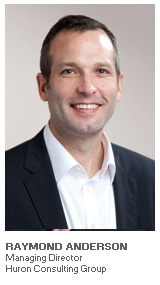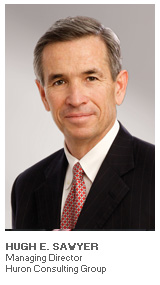
When specialty bag manufacturer Bancroft Bag, Inc. found itself facing both internal issues and external challenges, its lender, Regions Business Capital, turned to Huron Consulting Group’s Ray Anderson and Hugh Sawyer to turn the nearly 90-year old company around. With Anderson in the senior leadership role, the Huron team conducted an end-to-end examination to figure out a quick solution. The result was almost magical and preserved this Monroe, Louisiana-based company so vital to the local economy.
While no business is guaranteed success, Huron Consulting Group’s work with the manufacturing company means that a brighter today and future for Bancroft are in the bag.
Editor’s note: This is the second of a three-part series that delves into the unique situations recognized by this year’s Turnaround Management Association (TMA) Turnaround and Transaction of the Year Awards. Huron Consulting Group’s work at Bancroft Bag won in the Turnaround of the Year in the Mid-Sized Company category. The series will first appear in conjunction with the TMA’s Annual Conference in Washington, D.C. on Oct. 3-5.
ABL Advisor: Please describe the significant events or circumstances at Bancroft Bag that lead to the company’s troubles. Were the problems brought on by internal issues, external events or a combination of both?

Raymond Anderson: I would say it is a combination of both. Bancroft Bag manufactures multi-layered paper bags similar to those used to package dog food. These bags are used principally for food products and industrial chemicals and that market had been in slow decline for some time as plastic replaced paper. So there was this technology change that had occurred and when you combine that with some of Bancroft’s internal challenges and financing constraints, the company found itself in the middle of a perfect storm. Everything came together at one time.
Post turnaround, Bancroft has experienced a fair amount of growth and success in food-based applications. Today, Bancroft’s business is a mix of consumer products and business-to-business applications.
Hugh Sawyer: Many things had impacted Bancroft’s performance and it’s particularly challenging when a company’s product becomes dated and is left behind as an industry evolves. This is a factor that impacted Bancroft’s performance. Not only did the company face its internal issues, but Bancroft’s competitors were actually taking market share and that was frightening. Although there was and continues to be a viable market for this product, Ray as Bancroft’s interim CEO had to deal with both internal and external challenges.
ABL Advisor: Could you say more about the internal issues that you as turnaround professionals had to impact?
Anderson: The company has been around for nearly 90 years. It is family owned and there were certain challenges with Bancroft being a closely held business. There had been a management change and when you put it all together, it wasn’t a good set of circumstances. Ultimately, the workforce and the management team came together to have this turnaround be successful and this was really rewarding. The company still faces many changes, but it is definitely headed down the right path.

Sawyer: Because the company had been debt-laden, it was unable to fully invest in many of the internal technological changes and manufacturing innovations that would improve productivity. In time, the human capital and leadership of the business became of vital importance to the turnaround and operational restructuring of the business. Therefore, a decision was made to change Bancroft’s leadership and to place Ray in the senior executive role. Frankly, that move helped to unburden the workforce and through Ray’s leadership, facilitated the renewal of the business .
I think it’s important to mention that there were certain moral imperatives here as well. This was not a circumstance that was driven only by the financials. Monroe, Louisiana is a small town and jobs are scarce there. Ray and I were particularly motivated to save this business and to save these jobs because many of the frontline employees and managers had spent their entire careers at Bancroft.
ABL Advisor: How was Huron Consulting Group brought into the company and how did you set about to uncover the root of the problems experienced by Bancroft?
Sawyer: We were introduced to Bancroft by the company’s lender, Regions Business Capital through our relationship with executives there. After we were engaged, we began our broad-based assessment of the company including the external forces impairing performance, and of course, an assessment of the internal operations. Essentially, it was a diagnostic process to find a cure for Bancroft.
Anderson: Initially, we learned about the company and the situation was pretty serious. The company experienced a dramatic reduction in profitability in a very short time, the likes of which I had never seen before in my career. There were no labor strikes or anything of that nature that we could point to as the source of the company’s problems. Because the issues were so deep and so dramatic, we had to conduct an end-to-end examination to figure things out. The process was a mixture of analytical approaches and what I would call touchy-feely interviewing and that helped us to uncover the source of the issues.
Sawyer: Sometimes as turnaround professionals, we get involved in situations where the problems are apparent. This wasn’t the case with the situation at Bancroft and we weren’t able to immediately determine what led to the company’s decline. In situations such as these, it’s very important to diagnose the issues accurately before beginning the treatment. Otherwise, the treatment will not work or worse, could lead to unintended consequences. We were able to solve the puzzle largely through Ray’s insight and insightful on-site work with the company’s employees.
We had to gain the trust from all of the constituents … particularly from the founder, the board, the management team and the lender. All of these constituents ultimately had a hand in the renewal of this business and that includes the lender who was supportive throughout the process. That’s particularly important in a turnaround that was substantially in free fall when we arrived.
ABL Advisor: What were the unique abilities or skills that the Huron team brought to the Bancroft Bag situation that brought about the effectiveness of the renewal particularly as they relate to the management and workforce being reinvigorated?
Sawyer: Huron has extensive capabilities in board governance and operational improvement in frontline management and leadership. We have a broad portfolio of experience in working with unions as well as with founders and owners. We have strong capabilities in optimizing performance in a manufacturing environment, particularly one that has not evolved its technology or equipment. Huron is committed corporately, as well as within our practice, to the moral imperative of leadership in circumstances where people’s livelihoods will be impacted by the work we do.
Anderson: Hugh speaks to Huron’s abilities in the broadest sense. I would add that the Bancroft engagement was not a situation where the turnaround was affected by one individual at our firm or one set of skills. I will say that one thing that was very helpful was the fact that Hugh had created a bond with the company’s founder, which made it very helpful to gain his trust and support of the process. In terms of board structure, this was absolutely critical. We reconstituted a formal board of directors and that was extremely effective in changing the direction of the company. Hugh’s contribution was integral in that regard.
In addition, we had a team of people that came into Bancroft and worked on the refinancing in terms of the modeling. We also had people in the manufacturing facility working to identify the issues there. In some situations, a turnaround manager can find one single course of action that you need to take and requires the use of a narrow set of skills. The situation at Bancroft required a broader portfolio of skills.
Prior to the turnaround, Bancroft’s board was basically not functional. We reconstituted the board with independent members and put formal reporting and governance procedures in place. That caused an entirely new dynamic because in many instances, owners will react more positively when they are surrounded by peers. A formal board setting can change the direction of a company pretty speedily. We’ve seen this happen in a number of our engagements.
ABL Advisor: Can you speak to the results of the turnaround from the financial perspective?
Anderson: As I noted, Bancroft had a dramatic decline in gross profit margins and most of that degradation came back and was eliminated within the first three months of the engagement. Due to some of the measures we were able to put in place, we were able to refinance the company thereby dramatically reducing the fixed expenses. Before the turnaround, given course and trajectory, Bancroft had very limited options. With the turnaround in place, the company was in the position to be refinanced by way of a very healthy process. It was a great result in every aspect.
ABL Advisor: As a turnaround professional and using Bancroft Bag as an example, how closely do you follow the company’s performance once your engagement with the company has concluded?
Anderson: I can tell you this. I spent a year of my life in Monroe and I became quite attached to the people I worked with at Bancroft. Obviously, I want them to succeed and prosper. To answer your question, I still keep in touch with the company and I still interact with the board members and officers there. And clearly, the industry’s challenges haven’t gone away. They are unionized and they deal with healthcare and issues like those, but the company has been able to sustain performance improvements. Due to the dynamics of the industry, Bancroft needs to continue to focus like a laser beam on those issues and continue to hold their performance … but everything is good for now.